A year of boardgames
Published on
I realised the other day that it’s a little over a year since I started building out a collection of board games1, and thought it’d be fun to go through the collection and what I think about the games in hindsight.
The beginning
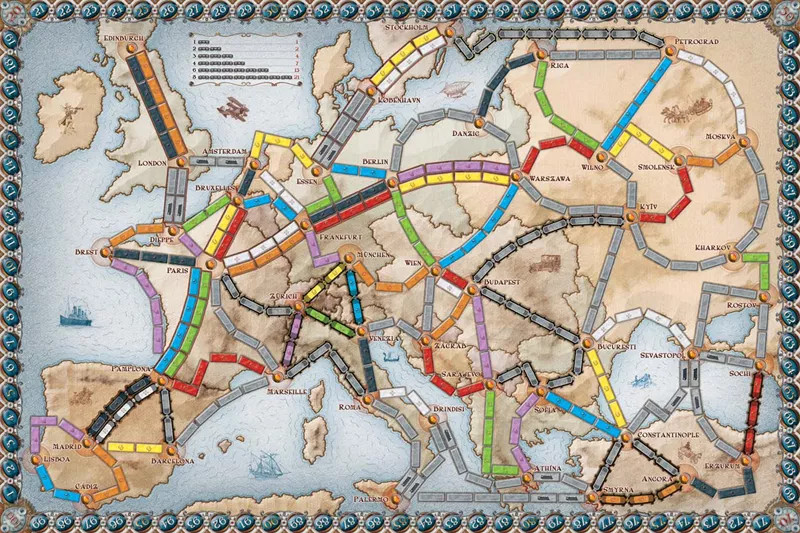
Ticket to Ride: Europe
I don’t remember how I discovered the concept of “modern” boardgames, but just over a year ago I purchased Ticket to Ride: Europe as my first. Prior to that I thought board games were like Scrabble, Monopoly, Trivial Pursuit, etc: they might provide a distraction occasionally, but didn’t amount to actual fun in the same way a video game might. I’d characterise those “classic” games as generally being extremely dependent on luck, not presenting many interesting choices, and generally being punishing if you’re behind.2
Ticket to Ride came as a breath of fresh air. You get to decide where to route your lines, whether you want to take on more cards, how aggressive to be in blocking the other players, and more. There’s still some luck involved, but it’s managed by being able to draw from a pool of visible cards, or being able to select which route cards you keep.
Shortly after I also picked up Carcassonne, and was similarly enamoured. I’ve not played either of them recently, though: they both fall into a weird little gap for me. While I enjoy the games, I don’t like playing them with certain groups3, but I don’t love them enough to prioritise them over other games when playing with other groups.
Pandemic

Pandemic
The next “gateway” game I picked up was Pandemic, which was my first co-operative game. I loved everything about it, and still do. The feeling when you managed to claw back a victory after setback after setback is great, but so is the shock when everything goes even worse than you thought possible!
Pandemic was also the first game where one of the mechanics caught my attention. The way epidemics work is that you take the bottom card from the infection deck, which becomes the center of the new outbreak, then shuffle that and all the discards back onto the top of the deck. It sounds simple, but it has big implications: everywhere that was previously infected can now be re-infected, and you’re guaranteed some tense rounds while you work back through those cards. It still blows my mind a little how shuffling and re-adding some card can mix up the game so much.
I still play Pandemic when I can, and it generally has a spot in my board game bag when I’m going away. I’ve since picked up the On the Brink expansion which adds some fun new twists4 to the base game, and Pandemic: Hotzone – Europe which plays similarly but is a bit quicker and smaller. I’ve also recently ordered Iberia, but it hasn’t materialised yet.
More gateway games
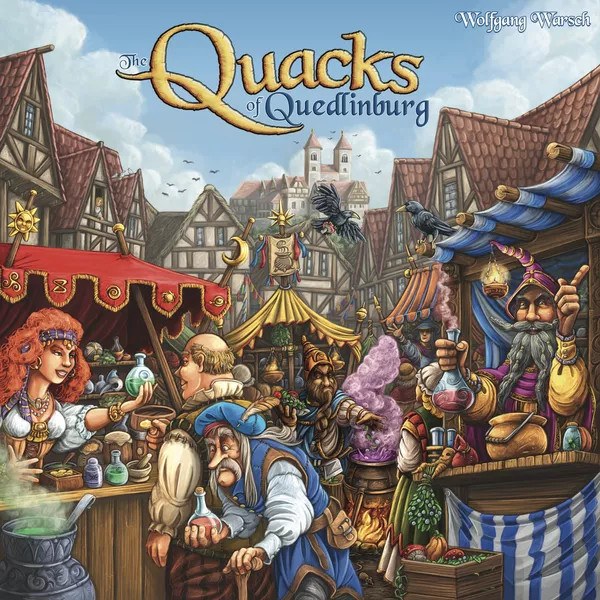
The Quacks of Quedlinburg
Over the next few months I picked up The Quacks of Quedlinburg, Azul (the mini variant), and Splendor. Quacks is probably my least favourite out of all the games so far: it’s not terrible, but it straddles deck-building and push-your-luck in a way that I don’t find particularly satisfying. It’s fun to play the combos you’ve invested in, and it’s fun to try and push your luck, but it’s not really fun when failing at the luck element means you don’t get to use the stuff you were building.
Quacks does bear the distinction of being the first game I customised, though: it got a little plastic organiser to hold all the ingredients instead of having to sort through a massive plastic bag with them all mixed in. My appreciation for game boxes with good built-in storage has gradually increased over the year, as have the tools I have for fixing those that don’t. But we’ll get back to that…
Azul is fun when you’re in the right mood; I’m not terribly into abstract strategy games, but Azul is light enough that it’s enjoyable. Splendor, on the other hand, I really like. So much so that I wrote a digital re-implementation of it. Both Azul and Splendor allow you to mess with your opponent a little, but not too much, which keeps it interesting but also means it still plays well in groups that don’t like too much head-on confrontation.5
I think the thing that really caught my attention in Splendor, though, is the quasi-engine building you do. It’s not actually classed as an engine builder on BoardGameGeek, but as you collect cards you get discounts on other cards, which lets you get better cards and further discounts, and so on. I love that kind of positive feedback loop in video games, and I apparently love it in board games as well.
Terraforming Mars
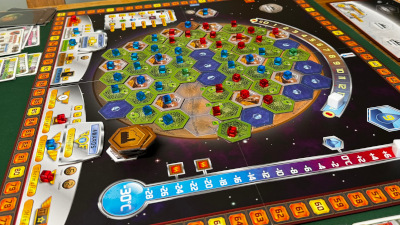
A recent game of Terraforming Mars
I’d heard lots of good things about Terraforming Mars, but I was worried it sounded a bit too complicated so put off buying it for a while. I mean, its weight on BoardGameGeek is orange. That’s scary, right?! Well… no. Terraforming Mars is easily my favourite board game, and I’ve played it pretty consistently since buying it. It has such a huge stock of cards that no two games feel the same: one game you might have an arsenal of cards that generate and use microbes; another you might have a plethora of science tags that let you play some of the most powerful project cards; next you might be spamming forests on Mars, or drowning in credits because you have too much income. It has the engine building element that I love, but I also really enjoy that it’s not always obvious who’s doing well and who’s not until the final score is tallied; that keeps everyone engaged and working on things for the entire game.
I’ve added in the Prelude expansion, which I wouldn’t play the game without now, and the Venus Next expansion, which adds some interesting bits but is nowhere close to being a hard requirement. I’ll probably pick up Colonies next. Prelude adds a new type of card that you take at the start of the game, which gives you a fairly hefty boost; these help you get off to a faster start, and may also affect what strategies you try to run with for the rest of the game. Venus Next adds another resource track, but you don’t have to complete it to end the game; it also adds a bunch of project cards that have “floater” resources, but they don’t feel that much different to the base game microbes6. One interesting thing that Venus Next adds, though, is a “solar phase” where one of the global parameters is increased at the end of each generation. The active player decides which parameter, but gets none of the benefits for it, so you get to decide entirely tactically.
There are two drawbacks to Terraforming Mars: it’s a little lengthy, and some of the components are a bit rubbish. Timing-wise, I find it takes a good hour and a half for a two player game, while adding a third player can almost double that. Obviously it depends who you’re playing with and what’s happening in the game, but that’s enough of a commitment that you more-or-less have to plan when to play instead of just spontaneously bringing it to the table. Component-wise, the game comes with basically no storage for anything other than little plastic bags that slosh around in the box; horrible plastic cubes for resource tracking that somehow jump out of your hand constantly, and flimsy printed sheets for putting those cubes on.
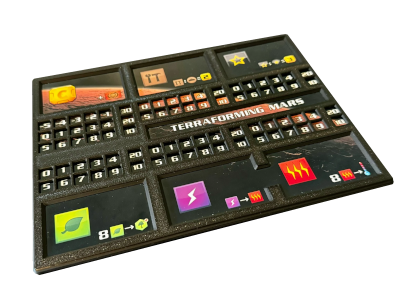
My custom player boards
The reason I got a 3D printer was in part so that I could make my own upgraded player boards that actually held the pieces in place instead of letting them fly everywhere if the table was slightly knocked. You can buy third party ones but I figured it was a teach-a-man-to-fish kind of situation, and dropping £200 on a 3D printer would save me money in the long run vs buying £50 of player boards someone else had made.7 About seven versions later, I have some boards which I think look and feel great. It’s 3D printed in two halves, then has a laminated 2D print sandwiched in the middle for all the markings and artwork.
As well as the player mats, I 3D printed some boxes, card holders, and so on, but have since replaced them with an insert from Folded Space. These are made of foam, and are perfectly sized to the game box and all the components in it. I could have eventually got to that point with 3D prints, but it would have taken a lot of time to design and print everything. Terraforming Mars was also the game that I first sleeved, as trying to shuffle the huge decks was an exercise in frustration. With all of the cards sleeved, not only are they more protected against wear and tear, you can now shuffle the deck just by gently mashing stacks of cards together. It makes shuffling so easy I now sleeve basically all my games as I hate having to riffle shuffle unsleeved cards.
Marrakech and HeroQuest
Later in the year I bought Marrakech after playing a giant version of it at a games expo. It sits somewhere between Azul and Splendor for me: it’s fun, and good when you want a short game, but it’s not high enough on my list to want to take it away with me. Playing with felt rugs does make a nice change from flipping cards or dealing with plastic components, though.
I also picked up HeroQuest at one point when it was on offer. It’s a good concept, and I felt like I would like it, but it was a bit of a let-down. The biggest problem for me is that you either need one player to basically be the DM, and manage the board, or you use an app to do that and have to deal with a bunch of admin and duplicating things because you’re half playing on the board and half in the app. I also don’t like relying on an app because I’ve been around long enough to know how easily computer software can become defunct, get removed from stores, get “updated” to remove features you need, and so on. I feel like the game would work well with five people: one to DM, and four to control the four heroes. But if you’ve got five people who want to play a dungeon crawler why aren’t you just playing D&D or a similar TTRPG? I’ll probably sell this at some point.
Party games
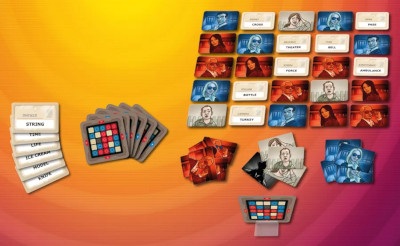
Codenames
These are all smaller games, and with most of them I’d played them before and decided I wanted my own copy. Codenames is my favourite party game, and I also picked up Codenames: Duet and they now live in the same box with a nice 3D printed insert. Codenames seems to just naturally produce fun moments: when an obscure clue is understood completely it feels amazing, but when it’s totally misunderstood it’s also generally hilarious. There’s also a great tension as the spymaster when you give a clue, then immediately realise it can be misinterpreted in a way that points straight at the assassin.
Poetry for Neanderthals is fun in the same party-word-game sort of way, but basically has no replayability. There are few enough cards that if you play a few times you can remember the “harder” word and just immediately guess it once you get the “easier” one being hinted (you can also sometimes just do this outright, which feels great but it kind of sucks from a gameplay point of view). The best bits are the inflatable “no stick” you get to bop people with, and how everyone speaks like a neanderthal for a little bit out of habit even after the game has ended. I seem to be weirdly good at this game, and I’m not sure what that says about me.
Love Letter has to take the spot of best game per cubic centimeter. It’s basically just a small set of cards, but it enables some really fun emergent gameplay. I really love how small the game is, and how easy it is to set up and play. It’s the perfect time filler. I’ve also played Lovecraft Letter, which adds a lot more complexity and was great fun, but is sadly out of print and I haven’t been able to find a copy at a sensible price.
Fluxx
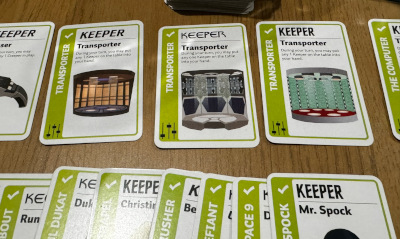
Star Trek mega-Fluxx
My arbitrary 12 month period ends not long after I went to a tabletop event and played, amongst other things, Cthulu Fluxx, Doctor Who Fluxx, and Star Trek: The Next Generation Fluxx. Each game has the same core Fluxx elements, but adds slight twists along with the unique themes. I ordered a copy of Star Fluxx, but then found out that you can combine the four Star Trek variants (TOS, TNG, DS9 and VOY) together with some expansions to make a mega game so ordered all of those as well. While putting together my mega-Fluxx order I noticed they had a Firefly Fluxx that was out of print so I snapped up one of the last copies of that, too.
I ordered most of the games direct from Looney Labs, as the out of print ones weren’t readily available anywhere else. Unfortunately, UK Border Force managed to misread the import label8 and demanded £300 of VAT and import duties on them! They refunded it eventually, but this small set of tiny games were for a little while the most expensive things in my collection.
Fluxx is fun enough, but the mega-deck version is brilliant. It gets much more chaotic, with multiple captains, teleporters, and other doodads in play to steal cards back and forth. I was worried it wouldn’t play well with non-Trekkies, but the cards from each series use a different font and the weird people that can’t identify Star Trek series based on uniform variations seem happy enough relying on that.
Future
A few more months have passed since then, and my collection is still growing. Board game stores have summer sales, it turns out! If my physical wallet was in any way involved in the purchasing flow I’m sure it’d be crying.
I’ve recently started logging my plays with BG Stats (which synchronises the information up to Board Game Geek). I’m interested to see if the hard numbers actually align with my conceptions of how often I play certain games. If I do another roundup in a year’s time, expect it to have a lot more stats in…
-
Other words that may be appropriate here: “hoarding”; “compulsively obtaining”; “spending all my money on”, etc ↩︎
-
Think about a game of Monopoly: what do you actually get to decide? It basically comes down to “buy or not” if you land on an available property, then later on “buy more houses or not”. ↩︎
-
e.g. a family member doesn’t like the farmer mechanic in Carcassonne, and I don’t find the game interesting enough without them. Nothing wrong with the game or the people, we’re just not going to both enjoy it the way we like when playing together. ↩︎
-
Which is definitely why I bought it. Not because it comes with amazing little petri dishes to keep the disease cubes in. Certainly not. ↩︎
-
There’s a different edge to taking a card that someone else wanted in Splendor — there’s twelve others they can pick from, or they can take a face down one, etc; it might be an inconvenience but you haven’t totally upended their plans — versus blocking a really long train line they were trying to build in Ticket to Ride. ↩︎
-
Floaters are meant to be big pieces of infrastructure that float in the atmosphere of Venus. The fact that they feel exactly the same way as tiny little microbes when played seems wrong. ↩︎
-
Having since bought a more expensive printer, I think I’m past the point of convincing myself it’s “cheaper”. It’s a lot more fun, though, and if you design parts yourself you end up with exactly what you want! ↩︎
-
Turns out the “weight (lbs)” column is not the “quantity” column. Who knew? ↩︎
Thanks for reading!
Have thoughts? Send me an e-mail!
Related posts
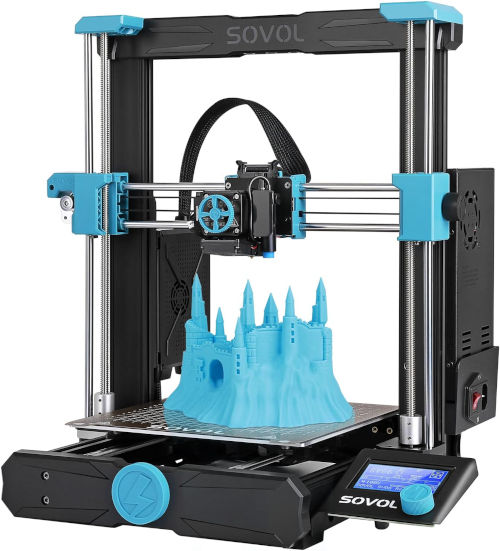
Adventures in 3D printing
I’d been idly considering getting a 3D printer for a while, but have only recently taken the plunge. I picked up a Sovol SV06 from Amazon for £199.99, which is a model commonly recommended for beginners. About three weeks later, I think I’ve finally finished fixing all the problems the printer has, and thought I’d document them. Setup and out of the box performance The setup of ...

Building a new Computer
I recently built a new computer, after exclusively using a laptop for three years. It’s also the first time I’ve departed from the usual combo of an Intel CPU and Nvidia GPU. While the form factor of a laptop did make it amazingly handy for travelling and attending LAN events, it was starting to show its age and there was basically no sane upgrade path. The main problem was its 3060 mo...

Generating infinite avatars
I recently added a new ‘about’ section to the top of my website. Like most about pages, it has a picture. Instead of a normal photograph, however, you’ll see an AI-generated avatar. This is admittedly fairly trendy at the minute – apps like Lensa offer to make you profile pictures if you give them a set of photos and some cash – but I’ve done something a bit dif...
I realised the other day that it's a little over a year since I started building out a collection of board games[^1], and thought it'd be fun to go through the collection and what I think about the ga...